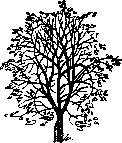 Cascara sagrada
Cascara sagrada
Rhamnus purshiana DC.
Introduction
Cascara is an erect, tall shrub, or less frequently a small tree. It is very shade tolerant and usually grows in intermediate seral stages, as a long-lived understory component. It often occurs on lower mountain slopes, and has a very scattered distribution (Klinka et al. 2000). Cascara provides good cover but has limited forage value for wildlife. The bark contains a laxative compound and was harvested commercially for this reason. In Washington and Oregon, plantations were established for bark production. In Canada, a permit was needed to cut Cascara on crown land (Lauriault 1989). After a synthetic source was found the legislation was rescinded (Parish et al. 1994). Cascara occasionally grows to more than 50 years old (Klinka et al. 2000).
Cascara’s range includes a large stretch in the central and south Pacific regions, along the coast from British Columbia to northern California, as well as in an area in the central Cordilleran region where it occurs less frequently, from southeast British Columbia to northern Idaho and Montana (Little 1976; Little 1977; Klinka et al. 2000).
Distribution and Protected Areas – from Hamann et.al. 2005



Conservation Status Summary – from Chourmouzis et.al. 2009
“On the coast, Cascara is well protected in the CWH but not in the CDF zone, where ground truthing is recommended. However, as protection appears lacking for interior populations, ground truthing efforts in the ICH zone, starting in the Shuswap area, should be given higher priority.”
Reproduction
The reproduction capacity of Cascara is low because few individuals produce fruit in the understory. Seeds are distributed by birds. Cascara needs light and exposed mineral soil for germination and establishment (Klinka et al. 2000). Cascara will coppice and also spreads by layering (Habeck 1992).
Genetic structure
No information available.
Resource management and seed transfer
No information available.
REFERENCES
Hamann, A., Smets, P., Aitken, S. N. and Yanchuk, A. D. 2005. An ecogeographic framework for in situ conservation of forest trees in British Columbia. Can. J. For. Res. 35:2553-2561. View online resources for this report.
C. Chourmouzis, A.D. Yanchuk, A. Hamann, P. Smets, and S.N. Aitken. 2009. Forest Tree Genetic Conservation Status Report 1: In situ conservation status of all indigenous BC species. Centre for Forest Conservation Genetics, Forest Genetics Council of BC, and BC Ministry of Forests and Range, Forest Science Program, Victoria, BC Technical Report 053. www.for.gov.bc.ca/hfd/pubs/Docs/Tr/Tr053.htm
Klinka, K., Worrall, J., Skoda, L. and Varga, P. 2000. The distribution and synopsis of ecological and silvical characteristics of tree species of British Columbia’s forests. Canadian Cartographics Ltd., Vancouver. 180 p.
Lauriault, J. 1989. Identification guide to the trees of Canada. Fitzhenry & Whiteside, Markham, Ontario. 479 p.
Little, E. L., Jr. 1976. Atlas of United States trees, volume 3, minor western hardwoods. U.S. Department of Agriculture Miscellaneous Publication 1314. 13 p., 290 maps.
Little, E. L., Jr. 1977. Atlas of United States trees, volume 4, minor eastern hardwoods. U.S. Department of Agriculture Miscellaneous Publication 1342. 17 p., 230 maps.
Parish, R., Thomson, S. M., Coward, G., British Columbia. 1994. Tree book: learning to recognize trees of British Columbia. Canadian Forest Service, Victoria, B.C. 183 p.
